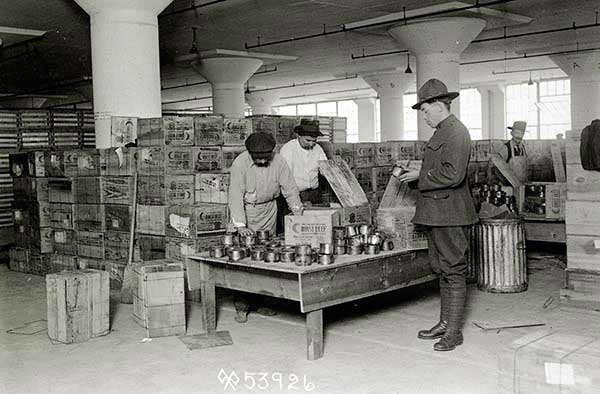The Frenchman Philippe de Girard took the idea of canned food to England around 1810. He then developed the initial concept of preserving food in metal cans rather than glass jars. Through numerous storied business deals, the idea subsequently passed into the hands of Bryan Donkin who developed the process of packaging food in sealed metal cans made of tinned wrought iron. At this time, the cans were large handmade items and required as much as 6 hours to cook. This resulted in a viable canned product that was very expensive, but nonetheless, feasible.
Because of the high expense, the British Army and Navy were realistically the only market for canned foods because necessity mitigated the cost. By 1817, canned food became more common, but was still limited primarily to military use.

Industries of War - Canning - Manufacturing cans for the Government at the National Can Company plant, Detroit, Michigan.
Photo: War Department. May, 1918.
National Archives and Records Administration.
Still Picture Branch; College Park, Maryland.
In the United States, the first canning factory was established by Robert Ayars in New York City concurrently with the War of 1812. Ayars used tin-plated wrought-iron cans to preserve everything from meats to seafood to vegetables. Demand for canned foods increased greatly during times of war and there were many of them in diverse places during the late 1800s. This served to introduce masses of people to canned foods and fostered its acceptance into culture at large. Companies engaged in the production of canned foods for militaries were able to continue production in times of peace by transferring product to civilian markets.

Industries of War - Canning - Inspection of meats at Bush terminal, Army Warehouse.
The inspection of Armour & Company canned roast beef.
Photo: Lt. Morrison, US Army Signal Corps, May, 1919.
Department of Defense. U.S. Army Materiel Command.
National Archives and Records Administration.
Still Picture Branch; College Park, Maryland.
During this period, militaries were directly involved in developing the processes of canning and also in quality control of the finished product. Canned foods became available in much greater varieties from the late 1800s leading up to World War I.

Industries of War - Canning - "Sanitary" cans are used and this machine places the tops on the cans. Hoopeston Canning Co., Hoopeston, Illinois.
Photo: War Department. 1918.
National Archives and Records Administration.
Still Picture Branch; College Park, Maryland.
By the middle of the 1800s, canned food began its transfer to civilian uses although it was still very expensive. As the manufacturing process was mechanized, developed and improved, largely through military efforts, canned food became more practical. This helped feed the rapidly urbanizing populations in industrial centers. By the 1860s, mass-produced machine-made steel cans were available. Because the cans were smaller, cooking times were reduced to about 30 minutes. This helped reduce the cost of canned food and facilitated its proliferation.

Inspecting food for U.S. Army. Examining canned peas. 30 April, 1919.
Photo: Sergeant McGarrigle. US Army Signal Corps.
Department of Defense. U.S. Army Materiel Command.
National Archives and Records Administration.
Still Picture Branch; College Park, Maryland.
Today, thanks to military technology transfer, canned food is an everyday thing.

Can All You Can, Its a Real War Job!.
Poster: Office for Emergency Management. Office of War Information. Domestic Operations Branch. 1943.
National Archives and Records Administration.
Still Picture Branch; College Park, Maryland.